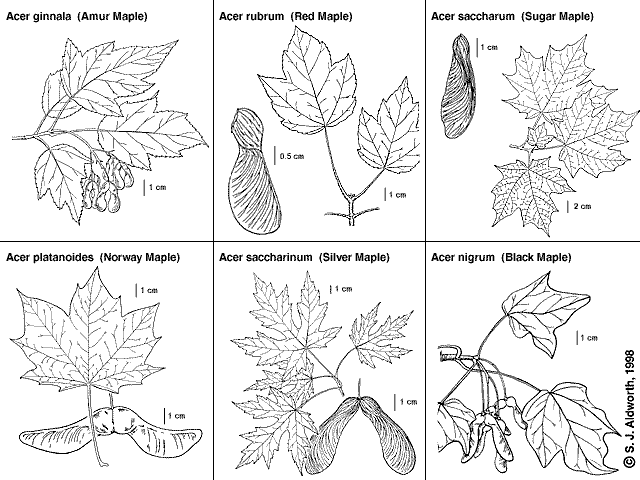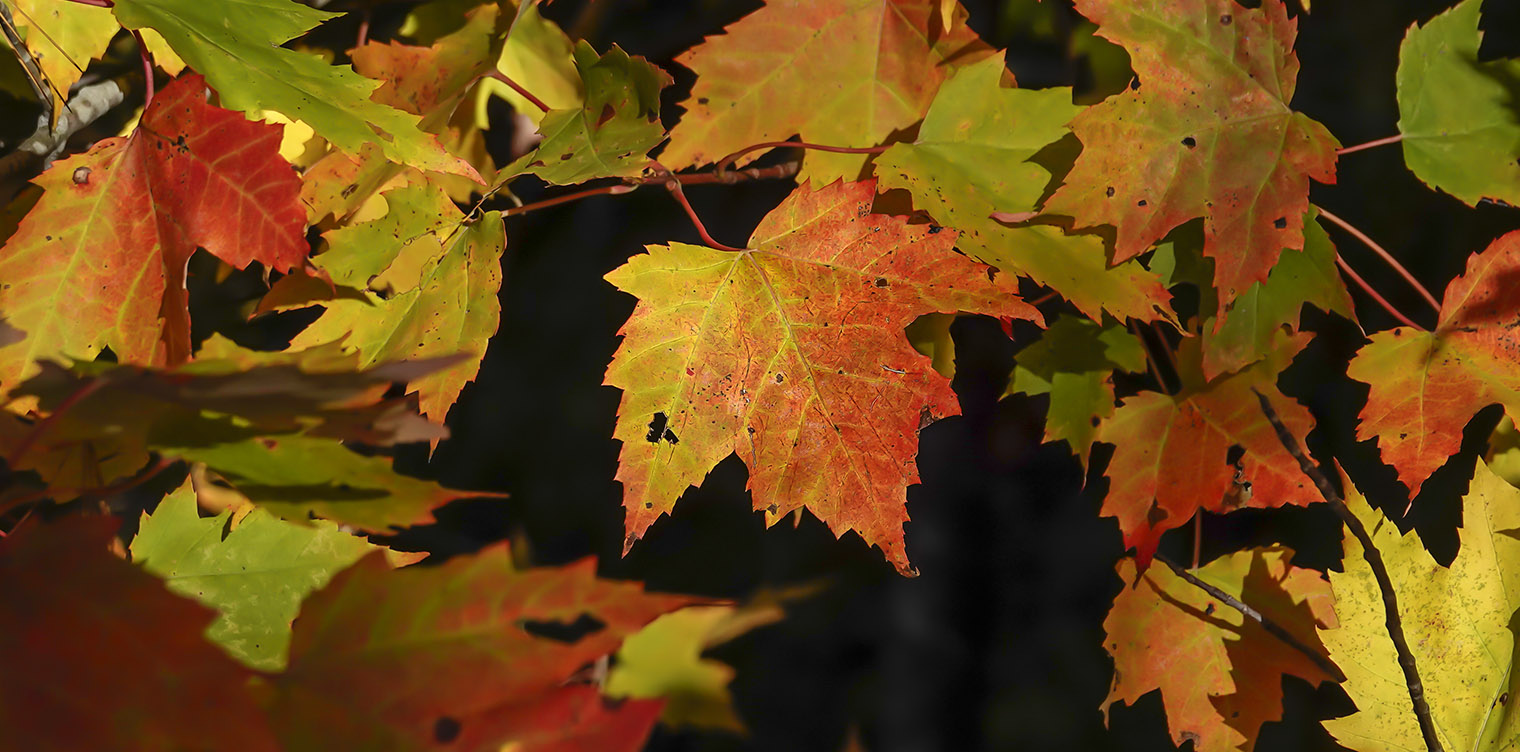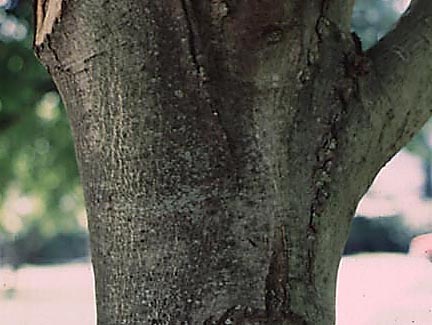
Identifying Red Maple Trees by Their Leaves And Bark: Expert Tips
Red maple trees have leaves with serrated edges and a V-shaped sinus. Their bark is smooth and grey on young trees.
Red maple trees, scientifically known as Acer rubrum, are common in North America. Their distinctive leaves and bark make them easy to identify. The leaves have a unique shape with pointed lobes and serrated edges. In autumn, they turn vibrant shades of red, orange, or yellow, adding striking color to landscapes.
Young red maple trees have smooth, grey bark, while mature trees develop rough, scaly bark. These trees thrive in a variety of soil types and are often used in urban landscaping. Identifying red maple trees by their leaves and bark is straightforward once you know what to look for.

Credit: wildadirondacks.org
Red Maple Leaf Characteristics
Identifying a Red Maple Tree often starts with its leaves. The leaves of the Red Maple tree are unique and beautiful. They provide important clues to identify the tree. Let’s explore the characteristics of these leaves.
Shape And Size
The leaves of the Red Maple tree have a distinct shape. They are usually lobed with three to five lobes. The lobes have pointed tips. The size of the leaves varies. Most leaves are between 2 to 6 inches long and wide. Each leaf has a serrated edge, making it easy to distinguish.
Color Variations
Red Maple leaves show a range of colors. In spring, the leaves are often reddish. By summer, they turn green. The green can be light or dark. In fall, the leaves turn bright red, yellow, or orange. This color change is a beautiful sight. The vibrant colors make Red Maple trees stand out.
Seasonal Changes
Red Maple leaves change with the seasons. In spring, new leaves emerge reddish. During summer, they turn green. As fall approaches, the leaves change color again. They turn bright red, yellow, or orange. In winter, the leaves fall off, leaving the tree bare.
These characteristics make Red Maple leaves unique and easily identifiable. By understanding their shape, size, color variations, and seasonal changes, you can identify a Red Maple tree with ease.
Bark Features Of Red Maple
Red Maple trees are not only known for their vibrant leaves but also their unique bark. Identifying these trees by their bark can be a fun and educational activity. This guide will help you recognize Red Maple trees by examining their bark characteristics.
Texture And Color
The bark of a Red Maple tree is smooth when the tree is young. It has a grayish color. As the tree ages, the bark becomes rougher and develops vertical ridges. These ridges can be shallow or deep, depending on the tree’s environment.
The color of the bark can range from light gray to dark gray. In some cases, you might notice a reddish tinge, especially in younger trees. This reddish hue is a distinctive feature of the Red Maple.
Age-related Changes
Red Maple bark changes significantly as the tree ages. Young Red Maples have smooth, light-colored bark. As they grow older, the bark becomes rough and develops cracks.
Older trees often have bark that peels away in strips. These strips can be several inches long. The peeling bark helps identify older Red Maples easily.
Comparisons With Other Maples
Comparing Red Maple bark to other Maple species can help in identification. The Sugar Maple, for example, has darker and rougher bark even when young. Silver Maples have bark that peels in long, thin strips, unlike the shorter strips on Red Maples.
Here’s a table to summarize the differences:
| Tree Species | Bark Texture (Young) | Bark Texture (Old) | Color |
|---|---|---|---|
| Red Maple | Smooth | Rough, Peels in short strips | Gray with reddish tinge |
| Sugar Maple | Rough | Very rough, deeply furrowed | Dark gray |
| Silver Maple | Smooth | Rough, Peels in long strips | Light gray |
Habitat And Distribution
Understanding the habitat and distribution of red maple trees helps in identifying them. Red maples are versatile and thrive in various environments. Knowing where they grow can make spotting them easier.
Preferred Environments
Red maple trees adapt to different habitats. They grow in wetlands, dry uplands, and forests. These trees are often found in areas with ample sunlight.
Wetlands: Often found near rivers, swamps, and bogs.
Dry Uplands: They grow well in dry, rocky areas.
Forests: Red maples are common in mixed hardwood forests.
Geographical Range
Red maples have a wide geographical range in North America. They are found from Canada to Florida.
| Region | Presence |
|---|---|
| Canada | Southern parts |
| United States | From Maine to Florida, west to Texas and Minnesota |
This wide range makes red maples one of the most common trees in North America.
Soil And Climate Preferences
Red maples prefer well-drained soil but are highly adaptable. They grow in sandy, loamy, or clay soils.
These trees thrive in various climates. They can withstand cold winters and hot summers.
- Soil Types: Sandy, loamy, clay
- Climate: Cold winters, hot summers
Their adaptability makes red maples resilient in many conditions. This versatility aids in their widespread distribution.
Common Look-alikes
Identifying red maple trees can be tricky. Many trees look similar. Knowing what to look for helps. Let’s explore common look-alikes.
Similar Maple Species
Several maple species resemble red maple trees. These include the sugar maple and the silver maple.
| Maple Species | Leaf Characteristics | Bark Characteristics |
|---|---|---|
| Sugar Maple | Leaves with five lobes | Dark, furrowed bark |
| Silver Maple | Deeply cut lobes | Light gray, flaky bark |
Distinguishing Features
Red maple leaves have three main lobes. The edges are serrated. The bark is smooth on young trees. It becomes rougher with age.
Sugar maple leaves have five lobes. The bark is darker and more furrowed. Silver maple leaves have deep cuts between lobes. The bark is light gray and flaky.
Other Confusing Trees
Other trees can also be confusing. These include the boxelder and the red oak.
- Boxelder: Compound leaves, greenish bark
- Red Oak: Lobed leaves, reddish-brown bark
Red maple identification is easier with practice. Focus on leaves and bark. Happy tree spotting!
Seasonal Identification Tips
Identifying Red Maple trees becomes easier with seasonal tips. Each season offers unique clues to help you recognize these trees. Let’s explore these seasonal characteristics.
Spring Characteristics
In spring, Red Maple trees have bright red buds. These buds bloom into small, red flowers. The leaves are light green with a reddish tint. The bark is smooth and gray on young trees. Older trees have rough, darker bark.
Summer Indicators
During summer, the leaves are a deep green. They have a distinct shape with three to five lobes. The edges of the leaves are serrated. The bark remains similar to spring. Look for smooth bark on younger trees. Older trees still have rough, dark bark.
Fall And Winter Signs
In fall, the leaves turn bright red. This is the most striking feature. The bark stays the same as in other seasons. In winter, the tree has no leaves. Look for the distinctive bark pattern. The twigs are reddish-brown and smooth.

Credit: www.waterfordcitizens.org
Importance Of Red Maple Trees
Red Maple Trees, known scientifically as Acer rubrum, are valuable. These trees are vital to our environment. They offer numerous benefits and have many uses. Understanding their importance helps us appreciate them more.
Ecological Benefits
Red Maple Trees play a crucial role in the ecosystem. They provide habitat and food for wildlife. Birds, squirrels, and insects thrive on them.
These trees also help in soil conservation. Their roots prevent erosion and stabilize the soil. This is essential for healthy landscapes.
Red Maples are good for the air we breathe. They absorb carbon dioxide and release oxygen. This helps reduce pollution and improves air quality.
Landscape Uses
Red Maples are popular in landscaping. They are known for their beautiful fall foliage. Their leaves turn bright red, adding color to gardens and parks.
These trees are versatile and can grow in various soils. They adapt well to different environments. This makes them an ideal choice for urban areas.
Red Maples provide shade and cooling effects. Their broad leaves create shady spots, making outdoor spaces comfortable.
Cultural Significance
Red Maple Trees hold cultural importance. They symbolize strength and resilience. Many people plant them as memorials or special events.
In some cultures, Red Maple leaves are used in art and crafts. Their unique shape and color inspire creativity.
These trees are also present in literature and folklore. They are often associated with nature’s beauty and change.
| Aspect | Details |
|---|---|
| Ecological Benefits | Habitat, soil conservation, air quality |
| Landscape Uses | Fall foliage, adaptability, shade |
| Cultural Significance | Symbolism, art, literature |
Challenges In Identification
Identifying Red Maple Trees can be tricky for many. Their leaves and bark often look similar to other species. This section will explore these challenges.
Common Misconceptions
Many people confuse Red Maple Trees with other maples. Their leaves can look like those of the Sugar Maple. The bark can also be misleading. Some think all maples have similar bark.
- Red Maple leaves have three to five lobes.
- Sugar Maple leaves are more rounded.
- Red Maple bark is smooth on young trees.
- Older Red Maples have broken, scaly bark.
Regional Variations
Red Maple trees vary by region. In the north, they may look different from those in the south. This makes identification harder.
| Region | Leaf Characteristics | Bark Characteristics |
|---|---|---|
| North | Leaves are smaller and darker | Bark is rougher |
| South | Leaves are larger and lighter | Bark is smoother |
Expert Advice
Experts suggest looking closely at the leaf shape and bark texture. Use a field guide for comparison. Pay attention to seasonal changes in leaves and bark.
- Check leaf lobes and edges.
- Observe bark texture and color.
- Compare with images in a field guide.
Tools And Resources
Identifying Red Maple Trees can be a delightful activity. Using the right tools and resources makes the task easier. Here are some great options to get you started.
Field Guides
Field guides are excellent for identifying trees. They provide detailed descriptions and pictures. National Audubon Society Field Guide and Pocket Field Guide to Trees are popular choices. These guides offer information on leaf shape, bark texture, and other identifying features.
| Field Guide | Features |
|---|---|
| National Audubon Society Field Guide | Detailed descriptions, high-quality photos, easy to use |
| Pocket Field Guide to Trees | Compact size, quick reference, covers many species |
Mobile Apps
Mobile apps bring identification tools to your fingertips. They are convenient and often free. LeafSnap and PlantNet are excellent apps to try. These apps use photos to help identify trees quickly. Some apps even provide additional information about the tree species.
- LeafSnap: Uses photos to identify trees, offers detailed information.
- PlantNet: Community-driven, identifies plants and trees, easy to use.
Community Resources
Community resources can be very helpful. Local nature groups often have experts who can help. Join a local botany club or a tree identification group. Libraries and schools may also have useful resources. Attending workshops can provide hands-on experience.
- Join local nature groups or botany clubs.
- Visit libraries for tree identification books.
- Attend workshops for hands-on learning.

Credit: ferrinbrookfarm.wordpress.com
Frequently Asked Questions
How To Identify A Maple Tree By Bark?
Identify a maple tree by its bark, which is typically smooth and gray when young, becoming furrowed and ridged with age.
How Do I Identify A Red Maple Tree?
Identify a red maple tree by its three-lobed leaves, red stems, and vibrant red autumn foliage. Its bark is gray and smooth when young, becoming rough with age. Red maple trees often grow in wet areas and have a distinct, upward-reaching branch pattern.
What Does The Bark Of A Red Maple Look Like?
The bark of a red maple is smooth and gray on young trees. It becomes rougher and develops vertical cracks as it ages.
What Is The Maple Tree With Red Leaves?
The maple tree with red leaves is often a Japanese Maple (Acer palmatum). These trees are known for their vibrant red foliage, especially in autumn. They thrive in well-drained soil and partial shade, adding striking color to gardens and landscapes.
Conclusion
Recognizing Red Maple trees by their leaves and bark is simple with practice. Look for the distinct leaf shape and texture. Examine the bark for its unique patterns. Mastering these identification tips will enhance your tree-spotting skills. Enjoy the beauty and diversity of Red Maple trees in your surroundings.

